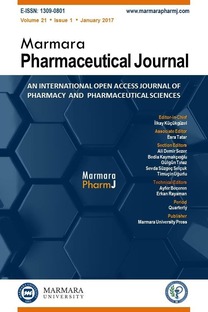The Effects of Preservation Methods of Grapevine Leaves on Total Phenols, Total Flavonoids and Antioxidant Activity
___
Gurib-Fakim A. Medicinal plants: Traditions of yesterday anddrugs of tomorrow. Mol Aspects Med 2006; 27: 1-93.Boudet AM. Evolution and current status of research inphenolic compounds. Phytochem 2007; 68: 2722-35.
Bombardelli E, Morazzoni P. Vitis vinifera L. Fitoterapia 1995;66: 291-317.
Dani C, Oliboni L, Agostini F, Funchal C, Serafini L, HenriquesJ, et al. Phenolic content of grapevine leaves (Vitis labruscavar. Bordo) and its neuroprotective effect against peroxidedamage. Toxicol In Vitro 2010; 24: 148-53.
Hmamouchi M, Es-Safi N, Essassi E. Oligomeric andpolymeric proanthocyanidins from Moroccan grapewine(Vitis vinifera) leaves. Fitoterapia 1997; 68: 332-7.
Kappor L. Handbook of Ayurvedic Medicinal Plants. CRCPress, Florida. 1990.
Orhan N, Aslan M, Orhan DD, Ergun F, Yesilada E. Invivoassessment of antidiabetic and antioxidant activitiesof grapevine leaves (Vitis vinifera) in diabetic rats. JEthnopharmacol 2006; 108: 280-6.
Mansour R, Ayed L, Hammami S, Mighri Z, Bakhrouf A,Mhenni F. Dyeing properties and antibacterial activities ofthe extracts of Vitis vinifera L. leaves,Tunisia. Tunisian J MedPlants Nat Prod 2011; 6: 126-32.
Kong JM, Chia L-S, Goh NK, Chia TF, Brouillard R. Analysisand biological activities of anthocyanins. Phytochem 2003; 64:923-33.
Yadav R, Agarwala M. Phytochemical analysis of somemedicinal plants. J Phytol 2011; 3: 10-4.
Wang L,Weller CL. Recent advances in extraction ofnutraceuticals from plants. Trends Food Sci Tech 2006; 17:300-12.
Blois MS. Antioxidant determinations by the use of a stablefree radical. Nature 1958; 181: 1199 - 1200.
Evans WC. Trease and Evans’ Pharmacognosy. Elsevier HealthSciences, London. 2009.
Harborne JB. Phytochemical Methods a guide to moderntechniques of plant analysis. Springer Science & BusinessMedia, Germany. 1998.
Quettier-Deleu C, Gressier B, Vasseur J, Dine T, BrunetC, Luyckx M, et al. Phenolic compounds and antioxidantactivities of buckwheat (Fagopyrum esculentum Moench) hullsand flour. J Ethnopharmacol 2000; 72: 35-42.
Batovska DI, Todorova IT, Bankova VS, Parushev SP, AtanassovAI, Hvarleva TD, Djakova GJ, Popov SS. Seasonal variations inthe chemical composition of vine-grape leaf surface. Nat ProdRes 2008; 22: 1231-6.
Liakopoulos G, Nikolopoulos D, Klouvatou A, Vekkos K-A,Manetas Y, Karabourniotis G. The photoprotective role ofepidermal anthocyanins and surface pubescence in youngleaves of grapevine (Vitis vinifera). Ann Bot 2006; 98: 257-65.
Stewart GF, Amerine MA. Introduction to Food Science andTechnology. Elsevier, Netherlands. 2012.
Sharma G, Prakash D, Gupta C. Phytochemicals ofnutraceutical importance: Do they defend against diseases.CAB International, Wallingford. 2014.
Guidoni S, Mannini F, Ferrandino A, Argamante N, Di StefanoR. The effect of grapevine leafroll and rugose wood sanitationon agronomic performance and berry and leaf phenoliccontent of a Nebbiolo clone (Vitis vinifera L.). Am J Enol Vitic1997; 48: 438-42.
Ayala-Zavala JF, Wang SY, Wang CY, Gonzalez-Aguilar GA.Effect of storage temperatures on antioxidant capacity andaroma compounds in strawberry fruit. LWT-Food Sci Technol2004; 37: 687-95.
Felicio J, Santos RdS, Goncalez E. Chemical constituents fromVitis vinifera (Vitaceae). Arquiv Instit Biol 2001; 68: 47-50.
Downey MO, Mazza M, Krstic MP. Development of a stableextract for anthocyanins and flavonols from grape skin. Am JEnol Vitic 2007; 58: 358-64.
Langcake P, Cornford C, Pryce R. Identification of pterostilbeneas a phytoalexin from Vitis vinifera leaves. Phytochem 1979;18: 1025-7.
Eftekhari M, Alizadeh M, Ebrahimi P. Evaluation of the totalphenolics and quercetin content of foliage in mycorrhizalgrape (Vitis vinifera L.) varieties and effect of postharvestdrying on quercetin yield. Ind Crops Prod 2012; 38: 160-5.
Baytop T. Therapy with medicinal plants in turkey (Past andpresent). Istanbul University, Turkey. 1999.
Jaradat NA. Medical plants utilized in Palestinian folkmedicine for treatment of diabetes mellitus and cardiacdiseases. J Al-Aqsa Unv 2005; 9: 1-28.
Czarniecka-Skubina E. Effect of the material form, storage andcooking methods on the quality of Brussels sprouts. Polish JFood Nutr Sci 2002; 11: 75-82.
Lohachoompol V, Srzednicki G, Craske J. The change of totalanthocyanins in blueberries and their antioxidant effect afterdrying and freezing. J Biomed Biotechnol 2004; 5: 248-52
Rice-evans CA, Miller NJ, Bolwell PG, Bramley PM, PridhamJB. The relative antioxidant activities of plant-derivedpolyphenolic flavonoids. Free Radic Res 1995; 22: 375-83.
- ISSN: 1309-0801
- Yayın Aralığı: Yılda 6 Sayı
- Başlangıç: 1985
- Yayıncı: Marmara Üniversitesi
Cellular toxicity and biological activities of honey bee (Apis mellifera L.) venom
YAŞAR GÜLMEZ, ALİ AYDIN, İLYAS CAN, ŞABAN TEKİN, Ercan CACAN
HAYRUNİSA HANCI, Ahmet AYYILDIZ, Hakan İGAN
Processing and storage influence on scavenging activity of fruit juices
Iyad ALİ, Nidal Amin JARADAT, Abdel Naser ZAID, Quammar MOHAMMAD, Dua'a DWAİK, Ghosson AQEL
Taste Masked Oral Fast Dissolving Sublingual Strips of Rizatriptan Benzoate for Migraine Therapy
Kailas Krishnat MALI, Remeth J DIAS, Vishwajeet S. GHORPADE, Vijay D HAVALDAR, Bhimrao K. RUPNOOR, Nikhil S. DHANE
Kozmetik Ürünlerin Fototoksik Etkileri: Mekanizması ve Alternatif Test Metotları
Özge KÖSE, ÜLFET PINAR ERKEKOĞLU, SUNA SABUNCUOĞLU, Belma KOÇER GÜMÜŞEL
RP-HPLC Estimation of Alogliptin and Pioglitazone Simultaneously in Combined Tablet Dosage Forms
B. HARİBABU, P. Rama Krishna VENİ, K. Bala Murali KRİSHNA, K. Lakshmi PRAMEELA
Nidal Amin JARADAT, Abdel Naser ZAID, Fatima HUSSEN, Iyad ALİ
İlaç Formülasyonu Geliştirilmesinde Deney Tasarımı (DoE) Seçimi ve Kullanımı
Önder DEMİR, Buket AKSU, Yıldız ÖZSOY
Biological activities of aerial parts extracts of endemic Tanacetum argenteum subsp. argenteum
ALİ ŞEN, ÖZLEM BİNGÖL ÖZAKPINAR, AYŞE SEHER BİRTEKSÖZ TAN, ŞÜKRAN KÜLTÜR, Fikriye URAS, LEYLA BİTİŞ
